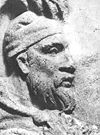- Decree of Dionysopolis
-
The Decree of Dionysopolis was written around 48 BC by the citizens of Dionysopolis (today's Balchik, on the Black Sea coast of Bulgaria) to Akornion, who traveled far away in a diplomatic mission to meet somebody's farther in Argedauon.[1] The decree, a fragmentary marble inscription, is presently located in the National Historical Museum in Sofia.[2]
Contents
Inscription
The decree mentions a Dacian town named Argedauon (Ancient Greek: Αργεδαυον), potentially Argidava or Argedava.
The stone is damaged and name was read differently by various editors and scholars:
- [ἐπορεύθη εἰς] Ἀργέδα[υι]ον by Wilhelm Dittenberger (1898)[3]
- [πέμψας?] Αρ[γ]έδα[ρ]ον by Ernst Kalinka (1905)[4]
- [...εἰ]ς Ἀργέδαυον by Wilhelm Dittenberger and Friedrich Hiller (1917), noting that the υ is an uncertain reading[5]
- Ἀργέδαβον by Vasile Pârvan (1923)[6]
The inscription also refers to the Dacian king Burebista, and one interpretation is that Akornion was his chief adviser (Ancient Greek: πρῶτοσφίλος, literally "first friend") in Dionysopolis.[7] Other sources indicate that Akornion was sent as an ambassador of Burebista to Pompey, to discuss an alliance against Julius Caesar.[8]
This leads to the assumption that the mentioned Argedava was Burebista's capital of the Dacian kingdom. This source unfortunately doesn't mention the location of Argedava and historians opinions are split in two groups.
One school of thought, led by historians Constantin Daicoviciu and Hadrian Daicoviciu, assume the inscription talks about Argidava and place the potential capital of Burebista at Vărădia, Caraş-Severin County, Romania. The forms Argidava and Arcidava found in other ancient sources like Ptolemy's Geographia (c. 150 AD) and Tabula Peutingeriana (2nd century AD), clearly place a Dacian town with those names at this geographical location. The site is also close to Sarmizegetusa, a later Dacian capital.
Others, led by historian Vasile Pârvan and professor Radu Vulpe place Argedava at Popeşti, a district in the town of Mihăileşti, Giurgiu County, Romania. Arguments include the name connection with the Argeş River, geographical position on a potential road to Dionysopolis which Akornion followed, and most importantly the size of the archaeological discovery at Popeşti that hints to a royal palace. However no other sources seem to name the dava discovered at Popeşti, so no exact assumptions can be made about its Dacian name.
It is also quite possible for the two different davae to be just homonyms.
Unfortunately, the marble inscription is damaged in many areas, including right before the word Argedauon, and it is possible the original word could have been Sargedauon (Ancient Greek: Σαργεδαυον ) or Zargedauon. This form could potentially be linked to Zargidaua mentioned by Ptolemy at a different geographical location. Or again, these two could be simple homonyms.
See also
Notes
- ^ Crisan 1978, p. 61.
- ^ Mihailov 1970.
- ^ Dittenberger 1898, p. 547.
- ^ Kalinka 1905, pp. 87,90-92.
- ^ Dittenberger & Hiller 1917, p. 446.
- ^ Pârvan 1923, pp. 14,29-30.
- ^ Daicoviciu 1972, p. 127.
- ^ Oltean 2007, p. 47.
References
- Crisan, Ion Horatiu (1978). "Burebista and His Time". Bucharest: Bibliotheca Historica Romaniae.
- Daicoviciu, Hadrian (1972). "Dacii". Bucharest: Editura Enciclopedica Româna.
- Mihailov, Georgi (1970). "Inscriptiones graecae in Bulgaria repertae" (in Latin and Ancient Greek). Sofia: In aedibus typographicis Academiae Litterarum Bulgaricae.
- Oltean, Ioana Adina (2007). Dacia: landscape, colonisation and romanisation. Routledge. ISBN 0415412528. http://books.google.com/books?id=wgvH2j7dWuEC.
- Pârvan, Vasile (1923). Consideraţiuni asupra unor nume de râuri daco-scitice. Bucharest. http://www.cimec.ro/Biblioteca-Digitala/pdf/dl.asp?filename=ParvanConsideratiuniAsupraUnorNumeDeRauriDaco-Scitice.pdf.
- Dittenberger, Wilhelm (1898). Sylloge Inscriptionum Graecarum. 2 (2 ed.). Leipzig.
- Dittenberger, Wilhelm; Hiller, Friedrich (1917). Sylloge Inscriptionum Graecarum. 2 (3 ed.). Leipzig. http://www.archive.org/stream/syllogeinscripti02dittuoft#page/446/mode/2up.
- Kalinka, Ernst (1905). "Antike Denkmäler in Bulgaria". Schriften der Balkankommission. 4. Vienna. http://www.archive.org/stream/schriftenderbal00abtegoog#page/n51/mode/2up.
External links
- Searchable Greek Inscriptions at The Packard Humanities Institute (PHI) - Argedava segment from Decree of Dionysopolis reviewed in Inscriptiones graecae in Bulgaria repertae by Georgi Mihailov
- A fost Argedava (Popesti) resedinta statului geto-dac condus de Burebista? - Article in Informatia de Giurgiu (Romanian)
Dacia topics Dacian tribes: Aedi · Albocense · Anartes · Apuli · Artakioi · Biephi · Biessoi · Buri · Carpi · Cauci · Ciaginsi · Clariae · Costoboci · Cotini · Crobidae · Daci · Getae · Moesi · Osi · Peukini · Piephigi · Potulatense · Predasense · Rhadacense · Saldense · Scaugdae · Sense · Suci · Terizi · Teurisci · Trixae · Tyragetae · Troglodytae
Dacian kings: Culture and civilisation: Art, jewellery, treasures, tools (Bracelets) · Clothing · Foreign Relations (Greeks · Celts · Romans · Germanic tribes) · Warfare (Falx · Sica · Thracian warfare)
Sarmizegetusa · Argidava · Buridava · Cumidava · Piroboridava · Sucidava · More towns... · Davae · Dacian Fortresses of the Orăştie Mountains · Murus dacicusWars with the
Roman Empire:Roman Dacia: Dacia Traiana · Moesia · Scythia Minor · Dacia Aureliana · Diocese of Dacia · Dacia Mediterranea · Dacia Ripensis · Trajan (Bridge · Column) · Towns and cities · Castra · Limes (Alutanus · Moesiae · Porolissensis · Sarmatiae · Transalutanus · Trajan's Wall · Brazda lui Novac) · Language (Thraco-Roman · Eastern Romance substratum)Research on Dacia: Books on Dacia · Dacian archaeology · Archaeological sites in Romania · Dacology · Thracology · ProtochronismWikiProject • Commons • Dacian fortresses, settlements, Roman castra, limes from Romania: Google Maps • Google Earth
Wikimedia Foundation. 2010.
